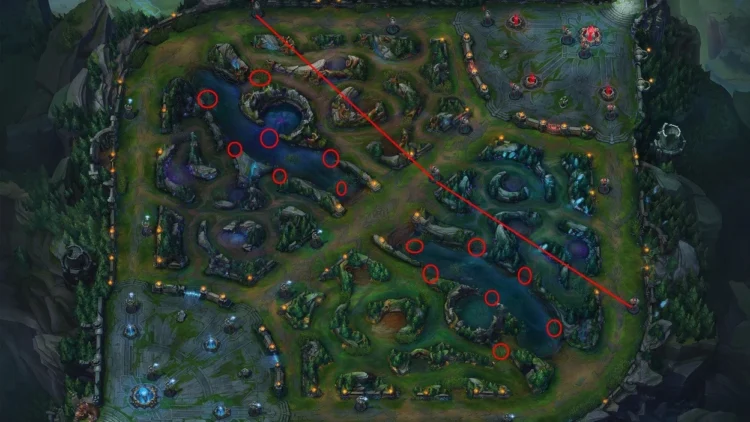League of Legends or as the pro calls it LOL, was first released in 2009, along with Dota 2, and has become the most well-known MOBA game. It has developed over time from a straightforward and enjoyable game that is typically played with friends into a highly competitive game with an incredibly talented community and professional players.
League has become synonymous with learning, growth, and improvement since both casual and professional players always want to better and correct even the tiniest errors in their games.
The most important concepts in the League theory, which is still a work in progress and is filled with game-defining concepts, are laning, team fighting, decision-making, and warding. All of these ideas are unquestionably crucial to master, but warding and Vision, in general, are sometimes overlooked, especially in low-Elo play.
You will struggle to survive the early game, triumph in the middle game, and win the late game if your vision control is inadequate. You may really assist yourself win more if you get the basics of warding and how to apply it to your advantage.
You’ll quickly learn that having strong vision control is essential for success as you advance and reach new levels in League of Legends. It is pivotal to understand and focus on how to improve at warding in League of Legends.
But first, let us understand what actually warding means.
What are Wards?
In League of Legends, there are items called Wards that, when used, provide players with vision. In the game, there are three warding items. Only two of them are Wards in actuality.
A ward is a deployable unit that clears the fog of war from a specific rift location. Placing wards is one method of clearing a section of the map that is obscured by fog.
What is Warding and Vision?
The fog of war is one of the most well-known League mechanics. The fog of war, which conceals the opposing team once they are in the safety of their own half of Summoner’s Rift, may be exposed by champions, turrets, abilities, and wards.
On the other hand, the phrase “vision” refers to both warding and breaking the adversaries’ wards in order to obstruct their view. Due to the fact that the bulk of your opponent’s area is frequently shrouded in the fog of war, controlling vision is crucial to winning the game.
By placing wards, you’ll be able to learn more about your adversaries’ whereabouts and activities. Wards also let you lane securely and get ready for enemy roaming ganks.
Who Needs to Ward?
Warding and visual control are among the responsibilities of the support. Supports have at least a Control Ward and four Stealth Wards, but they are not the only ones who can play the vision game. The maxim “the more, the better” holds true when it comes to vision since every piece of information you can gather may aid in guiding your decision-making process. Therefore, invest in a Control Ward anytime you have a spare room in your inventory and 75 gold in your account.
Types of Wards
| Totem Ward | Stealth Ward | Control Ward | Farsight Ward | Zombie Ward | Ghost Poro | |
| Life Span | 90-120 seconds | 150 seconds | Indefninte | Indefinite | 120 Seconds | 90 Seconds |
| Available level | 1 | 1 | 1 | 9 | Domination rune tree | Domination rune tree |
| Limit | 3 | 3 | 1 | No Limit | No Limit | No Limit |
| Recommended role | All Roles | Top, Mid Support | Jungle Support | Top, Mid, ADC | Build Dependent | Build Dependent |
| Range | 900 Units | 900 Units | 900 Units | 500 Units | 900 Units | 450 Units |
| Health | 3 | 3 | 4 | 1 | 1 | n/a |
| Visible | No | No | Yes | Yes | Yes | Yes |
- Totem Ward: Most champions start out with totem wards by default, thus it’s common to see them in the early stages of the game. For 90 to 120 seconds, totem wards give sight over the 900 units around them.
- Stealth Ward: When killed, stealth wards offer the same amount of visibility and experience as Totem wards. The primary distinction between the two is that Stealth wards can remain longer and grant additional gold when defeated.
- Control Ward: Control wards have the ability to detect and neutralize nearby non-control wards. They are the strongest kind of wards and can disclose traps and stealth wards. Frequently, top, mid lane and support players will purchase these wards.
- Farsight Ward: Wards produced by Farsight Alteration may be obtained by trading in other wards at the shop for farsight wards. Farsight wards only provide sight for the 500 units around them, but they are eternal.
- Zombie Ward: Zombie wards remain for 120 seconds, have one health, and are visible to the opposing team.
- Ghost Pro: The least effective ward is Ghost Poro, which only provides vision for 450 units around it.
Why is League of Legends Warding Important?
In order to succeed in a LoL battle, proper warding is crucial since it gives you a clear view of your opponents and the data you need to devise a winning plan. Knowing how, where, and when to ward is a crucial ability that may swiftly change the course of combat, even though it is largely the responsibility of support players. For instance, having good map vision can help you both attack precisely and defend against opponent ganks, reducing your losses in both situations.
Map vision ultimately gives you more battlefield control by letting you capture objectives, get ready for team battles, and finally knock down your adversaries’ Nexus.
Additionally, you can watch opponent rotations, locations, and even the items they’re creating to counter you with the use of deep wards when using warding and vision. This gives you time to prepare for an impending gank or team fight.
How to Ward in League of Legends Like a Pro?
Knowing when and where to ward depending on your position in the game is essential to improving your warding in League of Legends. Warding is crucial for top laners in the early laning phase to prevent ganks and gain intelligence for your team.
In order to prevent ganks, professional red side players typically ward the little tri-bush behind them. As the game goes on, you can add more wards to the pit to keep tabs on your rival’s progress toward the Rift Herald/Baron Nashor.
To learn about roaming attacks and prepare an adequate defense, mid players can ward the closest mid-lane bushes or even the opposing camps.
Though the opponent jungler doesn’t usually wander before 1:25, we advise holding onto your wards until then as you’ll learn less useful information and prevent having them demolished.
League of Legends Warding Tips
- You may target the majority of wards; but, doing so will expose you to the ward; examples of such spells are Teleport, Leap Strike, and Safeguard;
- Ward important routes and targets; the best wards are those situated close to jungle entrances and targets, such the Dragon and Baron pits;
- Get a Control Ward as soon as you can—especially if you’re laning alone—wards take effect after just one minute, so you need one right away;
- Place wards inside of brushes; wards inside of brushes expose adversaries concealed within and around them;
- You may target the majority of wards; but, doing so will expose you to the ward; examples of such spells are Teleport, Leap Strike, and Safeguard;
Early-Game Warding
As a general rule, early-game warding should be focused on preventing ganks and roams that are unanticipated. The opposing junglers’ camps can be strategically avoided by using deep river wards, contrary to the advice that is most frequently given: guard the nearest river bushes. These wards will let you to observe ganks coming from a great distance, giving you plenty of time to either flee the gank or prepare your counterplay.
However, we would advise not dropping any wards before than 1:25, as they offer little to no information and are likely to be destroyed, giving your enemy access to vital cash.
Mid and Late-Game Warding
Mid- and late-game warding often hinges on whether you’re playing defensively to scale and flip the game, or if you have a lead and want to expand that advantage.
Warding your own jungle to punish the isolated champions and eventually even out the gold disparity would be your best strategy if you’re playing from behind and are anxious to come back in the game.
Generally speaking, if you ever notice that the entire opposition team wandering over to Baron, it’s always worthwhile to place wards in the choke spots making sure that you can collapse easily and put a stop to them before they ever get near.
How to Ward After the Laning Phase
Place wards generally where you anticipate your team playing most of the time. In order to protect yourself better and attack lone enemies while working on your comeback, for instance, if you are on the back foot, you need wards in your own jungle.
But imagine that you are advancing successfully. To increase your lead and stop your opponents from farming even their own camps, you will need to place highly aggressive wards well into enemy territory.
As opposed to the river or your own jungle, we advised you to set extra wards around the enemy jungle. This is necessary because you want to surprise the opponent before they can leave their base too far. They would quickly be able to catch up on gold and start farming if they could travel about the jungle at will.
Best Places to Ward
The game has a lot of favorable locations for Ward. Naturally, some are better than others, but as long as they offer sufficient information, I’d say all venues are acceptable. Placing a Ward just to become similarly blind is what I’d call a terrible Ward, and these kind of Wards won’t be set frequently because practically every pixel of the map can use vision in some way.
In the Top Lane
A Control Ward should always be positioned on the left-side bush next to the top lane. You’ll be able to use this to disable the enemy’s Vision, keep them in the dark, get your own Vision, and create a route for your jungler to gank.
In the Bot Lane
One of the most significant and hazardous spots in the whole game is on the Bottom Lane Blue Side. Maintain constant vision over the Red Side Tri-Bush that is right over the Dragon pit. The opportunity to push the Lane with more safety and less concern about a backdoor gank is made available by the presence of a Control Ward in that Bush. Additionally, if your Lane is pushed towards the river, it will give your own jungler a safe way to try and gank.
In the Mid Lane
Given that these are the two most often used entrances to the Lane, it would be preferable if you warded both bushes immediately adjacent to your Lane. It is very advised that you guard the two bushes that are close to the aforementioned Baron and Dragon pits. It provides visibility of players attempting to avoid the large bushes and lane openings. If they are able to get beyond these, their efforts will be thwarted by Raptors or the Bush behind the Blue Buff.
How to Jungle Ward in LOL
For junglers, tracking your adversaries’ pathing, next play, and control objectives is the aim of warding. Your Red and Blue Buffs are the first location you should put a ward. This guarantees that you are informed of any potential opposing team invasion.
Warding within the baron and dragon pit will become more important as the game progresses. To allow their allies safer laning stages, the top jungle players also ward the opponent jungler’s camp.
You can always prepare an effective assault or defense since you have ward vision in both your jungle and that of your opponent.
However, setting up deep wards is a hazardous move, so you should only do it when you are certain you won’t be discovered, like after the opponent jungler has been killed.
FAQs
A Control Ward should always be positioned on the left-side bush next to the top lane. You’ll be able to use this to disable the enemy’s Vision, keep them in the dark, get your own Vision, and create a route for your jungler to gank.
Depending on how successful the ward is, each minute of its lifetime can award up to 1 point. Earning a takedown of a ward award 1 point for each minute the ward has life left (permanent wards are worth 1 point).
Blue wards will remain on the map until they are eliminated by an adversary. Basic attacks used by champions can target blue wards. They take 1 point of damage from each basic attack. Blue wards have a total HP of 1.
You can determine which side lane their mid-laner may be roaming to and whether the opponent jungler is crossing over to the other side by placing a ward in the middle of the lane. You can respond much more quickly since you notice the adversary just as they begin to rotate.
Conclusion
League of Legends is a highly situational game in which you must adjust to every circumstance from both the front and back. We’ve done our best to give you useful knowledge that will enable you to handle every circumstance and raise the quality of your warding.
In conclusion, warding and vision control are essential in League because they affect teams’ decision-making and make it possible to execute risk-free plays that might increase your lead. Tactical warding and vision control may also be your fortunate break to discover precious selections when you are behind and help you get back in the game.






